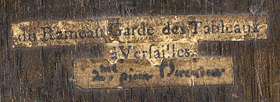The labels
Partly legible labels prove that the Mona Lisa was displayed at the Château de Versailles: “(…) au garde des Tableaux / à Versailles,” “(…)e pièce du Directeur.” Similar, better preserved labels on the back of La Belle Ferronnière (another portrait painted by Leonardo da Vinci) provide us with the name of Du Rameau, who was “Keeper of the King’s Paintings” at Versailles.

We know from the inventory of the king’s paintings (“l’Inventaire des Tableaux du Roi placés à la Surintendance”) that the Mona Lisa was hung in the apartments of the Count of Angiviller, Director General of the King’s Buildings.
“29”
This apparently insignificant number actually corresponds to the painting’s position on the list of the works that were selected and marked at Versailles during the French Revolution, on 27 Messidor An V (July 15, 1797), before being sent to the Museum Central des Arts (now the Musée du Louvre). The Mona Lisa eventually entered the museum’s collection on August 12, 1797, and was first presented to the public on February 6, 1798.
An inventory number
The panel bears the inventory number MR N°316, stenciled in red paint. This number does not correspond to today’s inventory, but was applied during the Restoration that followed the fall of the First Empire. It features the Bourbon royal crown above the letters M and R, for “Musée Royal” (founded by royal edict on July 22, 1816) on either side of a fleur-de-lys, symbol of French royalty.
“La Joconde”
The words La Joconde are handwritten in black chalk in the top left of the back of the panel; illegible, unidentified initials continue this inscription to the right. Both these elements, added to the poplar panel at an unknown date, have so far taught us nothing other than the name of the painting.
“H”
A letter H was written in sanguine in the center of the triangle formed by the inscription La Joconde, the dovetail joint, and the number 29. We know neither when nor by whom this inscription was made. According to a recent hypothesis, it could correspond to the word “Honda,” a transcription of the Florentine pronunciation of the word “Gioconda.”
Other traces could be indications or marks left by the successive manipulations and annual examinations of the painting.